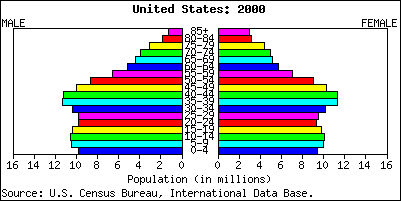BIOLOGY
by Miller & Levine
[complete Table of Contents]

|
Use the pull-down menu to jump to any of the Book's 40 Chapters: |
Additional Resources:
Population.com
A
web site with population statistics of countries worldwide, which includes
age-specific population data
In this chapter, you will read about patterns of population growth and the major factors that affect the growth of populations. You will also find out how biological and social factors affect the growth of human populations. The links below lead to additional resources to help you with this chapter. These include Hot Links to Web sites related to the topics in this chapter, the Take It to the Net activities referred to in your textbook, a Self-Test you can use to test your knowledge of this chapter, and Teaching Links that instructors may find useful for their students.
| Hot Links | Take it to the Net |
| Chapter Self-Test | Teaching Links |
What are Web Codes? |
Web
Codes for Chapter 5:
|

![]()
Section 5-1: How Populations Grow
![]() Three important
characteristics of a population are its geographic distribution, density,
and growth rate.
Three important
characteristics of a population are its geographic distribution, density,
and growth rate.
 Three factors affect population size:
the number of births, the number of deaths, and the number of individuals
that enter or leave the population.
Three factors affect population size:
the number of births, the number of deaths, and the number of individuals
that enter or leave the population.
 Under ideal conditions and with unlimited
resources, a population will continue to grow in a pattern called exponential
growth. As resources are used up and population growth slows or stops,
the population exhibits logistic growth.
Under ideal conditions and with unlimited
resources, a population will continue to grow in a pattern called exponential
growth. As resources are used up and population growth slows or stops,
the population exhibits logistic growth.
Section 5-2: Limits to Growth
 Density-dependent limiting factors include
competition, predation, parasitism, and disease.
Density-dependent limiting factors include
competition, predation, parasitism, and disease.
 Unusual weather, natural disasters, seasonal
cycles, and certain human activities—such as damming rivers and clear-cutting
forests—are all examples of density-independent limiting factors.
Unusual weather, natural disasters, seasonal
cycles, and certain human activities—such as damming rivers and clear-cutting
forests—are all examples of density-independent limiting factors.
Section 5-3: Human Population Growth
 Like the populations of many other living
organisms, the size of the human population tends to increase with time.
Like the populations of many other living
organisms, the size of the human population tends to increase with time.
 The characteristics of populations, and
the social and economic factors that affect them, explain why some countries
have high population growth rates while populations of other countries
grow slowly or not at all.
The characteristics of populations, and
the social and economic factors that affect them, explain why some countries
have high population growth rates while populations of other countries
grow slowly or not at all.